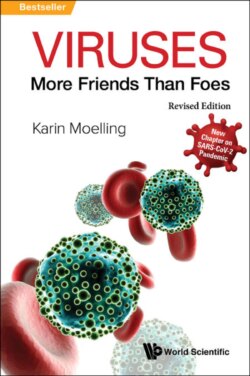Читать книгу Viruses: More Friends Than Foes (Revised Edition) - Karin Moelling - Страница 12
На сайте Литреса книга снята с продажи.
Measures taken
ОглавлениеEurope is watching China. China is about a month ahead of Germany in the development of the coronavirus outbreak, and Italy is ahead of Germany by one week. In the UK and the USA the virus may have arrived a month later than in Germany. The virus has arrived in big cities in the southern hemisphere, in the megacities first. Will it disappear in the northern hemisphere in the coming summer?
The most important parameters which lead to control of the outbreak in China have been described by George Gao, General Director of the Chinese CDC (Centre for Disease Control) in Beijing. He participated in the first sequencing of the SARS-CoV-2 genome and was interviewed by the established and excellent science journalist Jon Cohen for Science magazine (27.3.2020).
What kind of measures helped the most?
This is the summary: Social distancing, as a “pre-pharmaceutical strategy” (because there are no therapeutics); immediate isolation of infected cases; tracing and identification of their contacts and their isolation in quarantine; no assemblies, no crowds, no mobility, no travelling; lockdown; obligatory facial masks; and measurement of body temperature. It was surprising how the shortage of sufficient masks stimulated fake news about their usefulness — of course every mask is better than none.
Social distancing is the opposite of what the virus needs to get around so quickly — it prefers short distances, such the proximity of many people in marketplaces, in public transport and various other vehicles, and at mass events such as football matches or festivals. One has to cut off the path the virus could take — cordoning-off or closure. One has to isolate or “dilute out” the infected persons, so that the virus cannot move on. Furthermore, contacts have to be identified, and put into quarantine. Many countries are introducing or discussing the help by mobile phones to trace back contacts. Quarantine has been known since biblical times, such as leprosy, and was practiced to prevent spreading of disease from those who may have been infected, without — or before — a medical diagnosis. It was practiced against the bubonic plague in 1665. Quarantine was required for merchants and sailors before entering Venice. They were isolated for 40 days (whence we have the term “quarantine”). Harbor cities were especially exposed to the import of diseases of foreign origin — which corresponds to big cities with huge airport hubs today. Quarantine turned out to be extremely important for the elderly and they would have needed more protection because of reduced immunity and higher number of secondary diseases. The discussion about closing of schools is ongoing. In most countries schools have been closed, except for Sweden — with the important concept that children in regulated school systems can be better controlled in respect to contacts and chains of infections. Children’s infectivity is not fully known, they become infected by adults.
When people are locked into isolation, the virus may slow down — or escape and find other hosts. The virus CoV-2 has even been found in a lion in a zoo! This virus is so incredibly fit that it may, we hope, evolve to a reduced fitness — to use the terms we learnt from the great evolutionist Charles Darwin.
Viruses are undergoing speeded-up evolution. One can follow the changes and occurrence of mutations in real time. With about 30,000 bases in its single-stranded RNA genome, the coronavirus is large compared with many other viruses. The replication of its genome to generate progeny requires the genome to be copied, and the enzyme that does the copying is error-prone: it makes mistakes. Thus, the virus’s mutation rate is high, and a virus of this size would become extinct if too many mistakes were made. Indeed CoV-2 is the only virus known to have a correction system, called “proof-reading”, a system to eliminate a wrong base and thus to prevent mistakes from being passed down to the progeny. Indeed, CoV-2 is much less error-prone than other viruses are. This raises hopes for success of vaccines and therapeutics.
The Nobel prize-winning chemist and physicist, Manfred Eigen, who was greatly interested in the evolution of viruses, even conceived of an antiviral treatment that would work by pushing the virus replication to an intolerably high error frequency and thus forcing it to die out. He tried that for HIV — but no usable therapeutic emerged.
Can we expect the fitness of CoV-2 to decline? Today, we still do not know how the SARS of 2003 disappeared. It lost a fragment from its genome — but no correlation with the virus’s disappearance could be concluded. Furthermore, viruses are not a single defined species, but rather a swarm, also termed a “quasispecies” (M. Eigen). Not all viruses in this swarm are equally fit, and some of them may even lose fitness.
